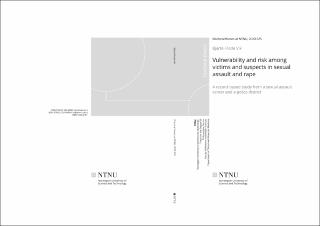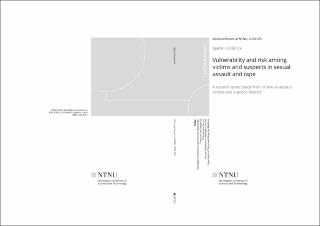| dc.contributor.advisor | Hagemann, Cecilie Therese | |
| dc.contributor.advisor | Rasmussen, Kirsten | |
| dc.contributor.advisor | Schei, Berit | |
| dc.contributor.author | Vik, Bjarte Frode | |
| dc.date.accessioned | 2020-11-10T12:46:56Z | |
| dc.date.available | 2020-11-10T12:46:56Z | |
| dc.date.issued | 2020 | |
| dc.identifier.isbn | 978-82-326-4999-0 | |
| dc.identifier.issn | 1503-8181 | |
| dc.identifier.uri | https://hdl.handle.net/11250/2687115 | |
| dc.description.abstract | To increase our knowledge about sexual violence against women, the three studies in this thesis aimed at analyzing and comparing subgroups of both victims and assailants, as evidence-based research on these topics is limited. This thesis examines how sexual assaults committed against women with certain vulnerability factors differ from assaults against women who do not have such vulnerability characteristics. Further, the quality of police investigations of these crimes is studied with regard to differences between the corresponding cases of victims with and without vulnerability. Finally, three categories of rape suspects are examined to detect differences in assault characteristics and police investigations depending on the category of the suspect involved.
The basis for Paper I was a relatively large collection of data from the Sexual Assault Center (SAC) at St. Olavs University Hospital in Trondheim, Norway, from the period 2003–2010. These SAC data (Paper I) were then merged with corresponding data from police files at the Sør-Trøndelag Police District (STPD), and Papers II and III were based on data from the merged data sources, but then with different perspectives. All three papers in the thesis have a retrospective and descriptive design, although Papers II and III could be seen as having qualities of a historical prospective cohort design.
There are four main themes: (a) the association between victim vulnerability and assault characteristics, (b) the association between victim vulnerability and police investigation, (c) the association between suspect category and assault characteristics, and d) the association between suspect category and police investigation.
Vulnerable groups of victims constituted the majority of women contacting the Trondheim SAC and the STPD after being sexually assaulted. There were obvious patterns of difference in characteristics of sexual assaults committed against women with vulnerability compared to those without vulnerability.
Victims without any of the vulnerability factors were more often young students and assaulted during or after social settings where alcohol, and relatively large amounts of it, was served. In the cases of vulnerable victims, and presumably by the nature of these victims’ inherent vulnerability, alcohol seemed to a lesser degree “to be needed” in order to attract, mislead, and abuse them.
We found a trend showing less thorough police investigation of rape cases if the victims had vulnerability than in cases where victims did not have vulnerability. The police less often interrogated witnesses other than the victim and suspect, and they also less often secured biological material from the crime scene in cases involving victims with vulnerability than in cases involving non-vulnerable victims. Patterns of rape were different depending on the categories of suspects involved. Cases involving suspects who had a criminal record as a former suspect of a sexual/violent crime (recidivist suspects), were investigated more thoroughly by the police and were more often prosecuted than cases where suspects did not have a record of such crimes. More knowledge is needed in the future to improve preventive and protective means toward groups of women who are at increased risk of being sexually assaulted. Future research should explore the presence of eventual rape myth endorsement among law enforcement personnel, and whether such preconceived attitudes bias police investigations in rape cases depending on the characteristics of victims and suspects. | |
| dc.language.iso | eng | en_US |
| dc.publisher | NTNU | en_US |
| dc.relation.ispartofseries | Doctoral theses at NTNU;2020:325 | |
| dc.relation.haspart | Paper 1:
Vik, Bjarte Frode; Nøttestad, Jim Aage; Schei, Berit; Rasmussen, Kirsten; Hagemann, Cecilie Therese.
Psychosocial vulnerability among patients contacting a Norwegian sexual assault center. Journal of Interpersonal Violence 2016 ;Volum 34.(10) s. 2138-2157
https://doi.org/10.1177/0886260516659657 | |
| dc.relation.haspart | Paper 2:
Vik, Bjarte Frode; Rasmussen, Kirsten; Schei, Berit; Hagemann, Cecilie Therese.
Is police investigation of rape biased by characteristics of victims?. Forensic Science International: Synergy 2020 ;Volum 2. s. 98-106
https://doi.org/10.1016/j.fsisyn.2020.02.003
This is an open access article under the CC BY license (http://creativecommons.org/licenses/by/4.0/) | |
| dc.relation.haspart | Paper 3:
Vik, Bjarte Frode; Rasmussen, Kirsten; Schei, Berit; Hagemann, Cecilie Therese.
Three groups of suspects in police-reported rape cases: First-time suspects, recidivists and unidentified suspects. A comparative study. Journal of Forensic and Legal Medicine 2019 s. 1-8
https://doi.org/10.1016/j.jflm.2019.02.004
This is an open access article under the CC BY license (http://creativecommons.org/licenses/by/4.0/) | |
| dc.title | Vulnerability and risk among victims and suspects in sexual assault and rape | en_US |
| dc.type | Doctoral thesis | en_US |
| dc.subject.nsi | VDP::Medical disciplines: 700::Health sciences: 800 | en_US |

